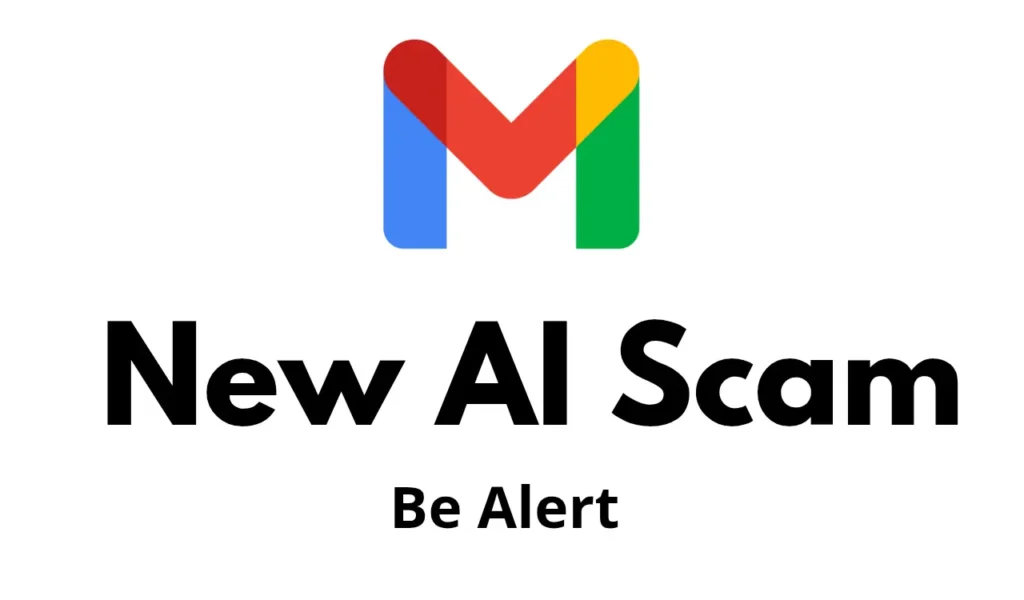Gmail Users Red Alert | New AI SCAM in Market
Table of Contents
In May 2024, a Gmail users red alert was issued regarding a new wave of AI-powered scams targeting Gmail accounts. The FBI issued a warning after the increasing use of artificial intelligence by fraudsters to craft highly convincing phishing emails, voice, and video messages aimed at stealing personal data and gaining unauthorized access to Google accounts. In this blog post, we’ll explore how these scams work, the dangers they pose, and the steps Gmail users red alert warns us to take to protect our personal information.
What Is the New AI Scam Targeting Gmail Users?

The Gmail users red alert was triggered after reports showed that attackers are using sophisticated AI technology to carry out scams. These attacks typically begin with a phone call from someone claiming that the user’s Gmail account has been compromised. This is followed by a legitimate-looking email that appears to come directly from Google. The goal is to trick users into providing their Gmail account’s recovery code, which allows the scammers to take full control of the account.
By gaining access to your Gmail account, attackers can not only steal personal data but also potentially commit identity theft. The Gmail users red alert is a reminder that the threat is real, and Gmail users should remain cautious.
How Do These AI-Powered Gmail Scams Work?
According to experts from Malwarebytes, the AI-driven Gmail scams unfold in a few steps:
- Initial Contact: You might receive a phone call or email claiming that your Gmail account has been compromised.
- Phishing Email: The scammers then send a convincing email, supposedly from Google, urging you to provide your Gmail recovery code to restore your account.
- Scam Success: If you fall for the scam, attackers gain access to your Gmail account and may use it to steal sensitive information or even impersonate you.
This new type of scam is alarming because the scammers are utilizing AI to create incredibly realistic voice, video, and email messages that are difficult to distinguish from legitimate communications. The Gmail users red alert stresses the importance of staying vigilant to these tactics.
How to Stay Safe from the Gmail AI Scam: Expert Tips
The Gmail users red alert comes with a clear set of instructions on how to stay safe from these AI-driven scams:
- Don’t Click on Unknown Links
Avoid clicking on links or downloading files from unexpected emails or messages, especially if they contain urgent warnings about your Gmail account. - Verify Security Alerts
Always verify any security alerts by logging directly into your Google account, not by using links in emails. This will help you avoid phishing traps. - Use Multi-Factor Authentication (MFA)
Enable MFA on your Gmail account and other important accounts. This adds an extra layer of security and makes it harder for scammers to gain access. - Be Skeptical of Unsolicited Communications
If you receive a message or phone call claiming your Gmail account is at risk, take the time to verify it through official channels. The Gmail users red alert specifically highlights that these scams often create a sense of urgency to make you act hastily. - Protect Devices with Updated Security Software
Ensure your devices are protected with up-to-date security software to block malicious attempts at phishing or malware installation. - Use a Password Manager
A password manager can help you securely store and autofill credentials on trusted websites, reducing the risk of entering your login information on malicious websites.
Why the Gmail Users Red Alert Is Crucial for Businesses
For businesses, especially in sectors like construction or finance, where email accounts often hold sensitive information, the Gmail users red alert is crucial. If a professional Gmail account is compromised, attackers can:
- Intercept Financial Transactions: Scammers may pose as clients or contractors and send fraudulent payment requests.
- Steal Sensitive Project Details: Confidential information related to ongoing projects can be exposed to unauthorized parties.
- Damage Reputation: If attackers impersonate your business and send fraudulent emails, your professional reputation may be damaged beyond repair.
To avoid these risks, businesses should take extra precautions, like using business emails with enhanced security features instead of personal Gmail accounts. The Gmail users red alert is a wake-up call for businesses to prioritize email security.
How to Protect Yourself as a Gmail User: Simple Steps
The Gmail users red alert is not just about protecting personal information but also about securing your digital identity. Here’s a quick checklist of steps you can take:
- Update your security settings: Make sure your Google account security settings are up to date and use MFA wherever possible.
- Monitor your account activity: Regularly check your Google account for unauthorized access and unusual activity.
- Educate yourself and others: Share this information with friends, family, and colleagues to help them stay safe from AI-powered scams.
- Report suspicious activity: If you think your account has been compromised, report it immediately to Google.
Conclusion: Staying One Step Ahead of AI Scams
The Gmail users red alert serves as an important reminder of the ever-evolving nature of cyber threats, particularly AI-driven scams. By following best practices like enabling MFA, being cautious about unsolicited communications, and regularly monitoring your accounts, you can protect yourself from these sophisticated threats. As Gmail users, staying aware and vigilant is the best way to avoid falling victim to scams that can result in identity theft, financial loss, and reputational damage.
Remember: when it comes to cybersecurity, caution is your first line of defense. Keep your Gmail account secure, and don’t let AI scammers catch you off guard. The Gmail users red alert is a signal to take action now!

Hi! I’m Sandip, a civil engineer who loves sharing about Civil Engineering & new ideas and tips. My blog helps you learn about engineering in a fun and easy way!
